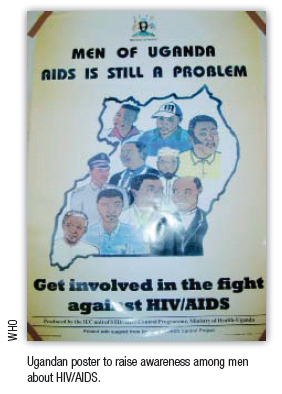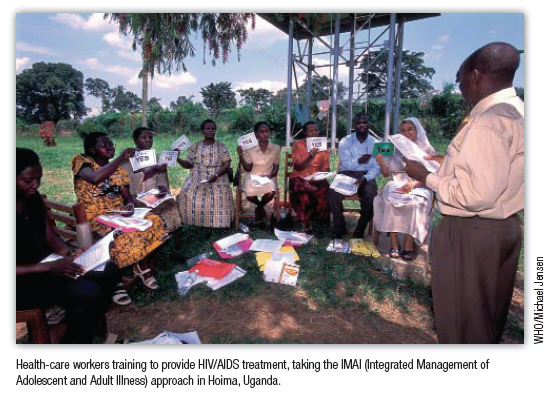NEWS
Uganda edges closer to AIDS treatment for all
Uganda started rolling out an innovative approach to treating AIDS three years ago. Treatment numbers have since doubled and the programme will soon benefit from locally produced medicines. But, as Musinguzi Bamuturaki reports from Kampala, the programme is dogged by inadequate staffing and logistics.
Uganda has seen the number of those accessing antiretroviral (ARV) drugs jump from 45 000 in 2004 to 121 200 in September 2007 a bit more than one-third of some 312 000 who need it. Although drug supplies have increased in volume, the national programme faces delays in procurement and distribution, poor storage and weak quality control, stock-outs and a chronic lack of manpower.
"The management of the whole supply chain is very weak and problematic," Dr Elizabeth Madraa, manager of Uganda's AIDS Control Programme in the health ministry, told the Bulletin. "We are now moving slowly as a result of the stock-outs because if we spread out rapidly and ran out of drugs, it would be disastrous."
"I think Uganda is making a lot of progress with regard to access to ARVs," the World Health Organization (WHO) Representative Dr Melville George says, adding that: "This in itself calls for a number of things like a good and reliable supply of drugs because if patients run out of ARVs they may develop resistance."
George suggested that Uganda needs to put in place a good community-based care system that will look at a comprehensive package to include nutrition, social support for patients, management of other opportunistic infections and other social responsibilities.
One of the beneficiaries of the government ARV programme is Elinah Kasubo. Access to ARVs has enabled the primary school teacher to live longer and continue working. But she complains of irregular drug supplies and a lack of antibiotics to fight infections that are a constant risk to people like her with weakened immune systems. "We want a stable and consistent supply of ARVs and treatment for opportunistic diseases."
Kasubo also complains of the queues teachers face when they fetch the drugs from government hospitals. "It takes a whole day lining up for ARVs in government hospitals because we are many. As if that is not enough, pupils missing their teacher for a whole day is too much."
AIDS and malaria are the biggest threats to the health of Ugandans and account for over 50% of the national health budget, according to the health ministry. The Ugandan government has committed itself to providing free ARVs and to treat malaria free artemisinin combination therapy to all those who need them. This is only possible if these remedies are available at prices the government can afford.
Uganda imports most of its drugs. But that may be about to change. The first batch of locally produced generic ARVs and antimalarial drugs are expected to be delivered to the health ministry this year in a move that will see the cost of these life-saving remedies dropping from between US$ 15 and US$ 9 to between US$ 9 and US$ 2 per patient per month, Ugandan officials say.
The drugs are to be produced by a pharmaceuticals factory in Kampala, a joint venture between Quality Chemical Industries Ltd. (QCIL), a local company, and Indian generics manufacturer, Cipla. The plant the first of its kind in east Africa opened in October 2007 in Luzira, a suburb of the city, to manufacture mainly ARV and antimalarial drugs.
In time, the plant is expected to lower the cost of these drugs and make them more widely available in Uganda. At one time, ARVs cost US$ 1500 per month, far beyond the pocket of the average Ugandan. The Ugandan government and QCIL signed an agreement in 2006 committing the government to buy ARVs and antimalarial drugs from the Luzira-based company. Approved in March 2008 by the National Drug Authority on behalf of the Uganda government, the new plant aims to produce two million tablets a day, once it achieves full capacity.
This year the government budgeted for an extra 50 000 patients out of the expected production in Luzira.
Uganda's ARV programme is 95% donor funded which raises the issue of sustainability. The programme is funded by the Global Fund to fight AIDS, Tuberculosis and Malaria, and the USA President's Emergency Plan for AIDS Relief.
Results from the 20042005 Uganda HIV/AIDS Sero-Behavioural Survey indicate that 6.3% of the adults aged 1559 were infected with HIV. The HIV prevalence among men was lower (5.2%) than among women (7.3%). Prevalence for both men and women increases with age until it reaches the peak of 12.1% among women aged 3034 years and 9.3% of men aged 4044 years.
With about one million people with HIV in Uganda, more than 312 000 people need antiretroviral treatment and about 121 200 have access to the life prolonging drugs with close to three-quarters as self-paying patients. Uganda also faces the challenge of establishing treatment formulations specifically for children with HIV. Ugandan government officials estimate that 10% of those in need of ARV treatment are children. Experts in Uganda are concerned that children with HIV are not adequately represented on the national antiretroviral programme. Currently they estimate that only about 8532 children are receiving this essential intervention.


"Children are very difficult to diagnose and identify because many are either with grandparents or guardians who may not be in a position to travel to health facilities. The paediatric formulations have not been user-friendly for the old grandparents or guardians to administer, coupled with [problems due to] measurements, poor storage, wastage and handling," Madraa says. As a result of the stigma attached to being HIV positive, many children are not benefiting, George adds.
The Ugandan government says it has yet to reach everybody who needs treatment. As of December 2007, 302 hospitals and health centres were providing ARV treatment. The plan is then to embark on health centres at sub-county level.
According to the health policy advocacy officer, Uganda Coalition for Access to Essential Medicines, Mr Aron Muhinda, people on the ARV programme have to travel long distances to access treatment, those on the government-run programme are not provided with a follow-up service and they do not have food supplements which puts their lives at risk. "There are no diagnostic materials like CD4 Count Machines up-country and where they are available people have to pay dearly," Muhinda noted.
Madraa says that, although Uganda has registered a treatment adherence rate of over 90% in its ARV treatment programme, monitoring mechanisms need to be put in place. "We need to constitute mechanisms to monitor those on treatment, because when you start treatment, you need a follow-up. The numbers not adhering may be as a result of transfers or deaths. Vigorous monitoring will handle issues, such as drug fatigue and resistance, and toxicity."
Through blood sampling, the Uganda Virus Research Institute has started researching to find out if there are any forms of drug resistance to ARVs, using the latest equipment purchased by WHO with Global Fund money.
Uganda has been chosen as a WHO Regional Centre of Excellence, known as the Eastern and Southern Africa Knowledge Hub, comprising six Ugandan institutions using the Integrated Management of Adolescent and Adult Illness (IMAI) guidelines by WHO. Over 2000 health workers have received training from the ministry of health and its partners in providing basic HIV and paediatric care using the IMAI approach. The training started in Uganda in 2004 with clinical teams. The Knowledge Hub has also been instrumental in supporting more than 20 countries in Africa and beyond to roll out IMAI training. This simplified approach to providing ARV treatment has been scaled-up in Ethiopia, Kenya, Sudan and the United Republic of Tanzania.
According to Dr Beatrice Crahay, WHO Medical Officer for HIV/AIDS in Uganda, the IMAI approach includes the task-shifting concept, meaning that jobs performed by doctors can be delegated to lower-level cadres under proper supervision. "And the people living with HIV have an important role to play in increasing the quality of care including adherence support and follow-up, treatment, literacy for people who have to go on ARVs, pre and post-test counselling," Crahay said.
"We are thinking of formalizing the task-shifting approach because of the human resource constraints," Madraa says. "The whole issue of management, counselling and testing, treatment, follow-up and supervision requires manpower," George said. 
